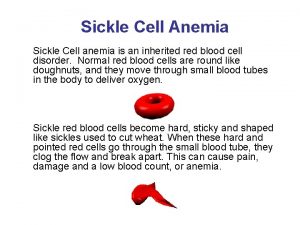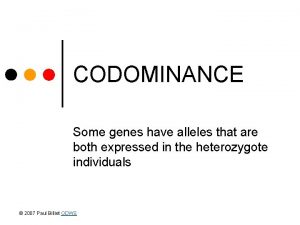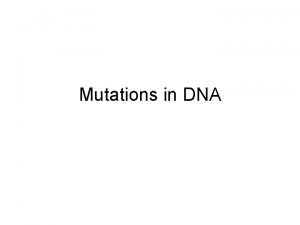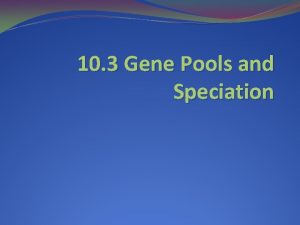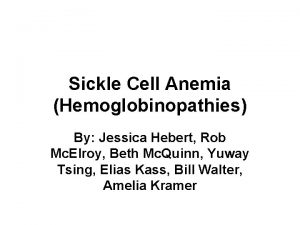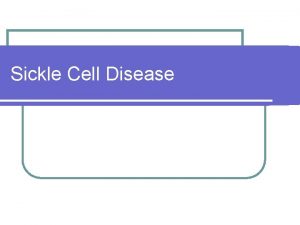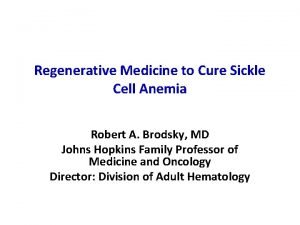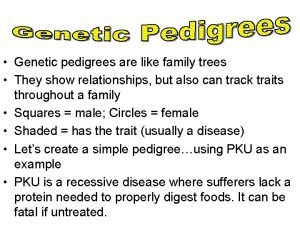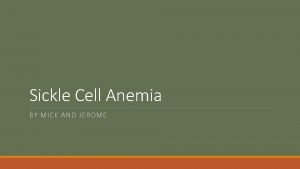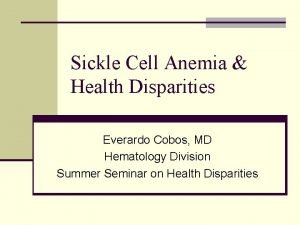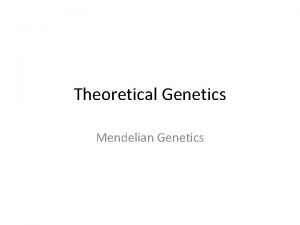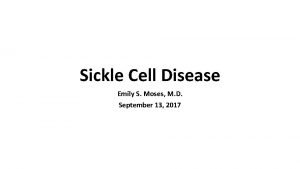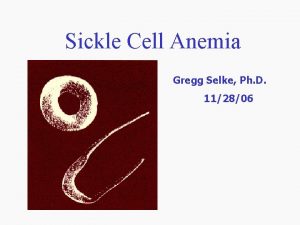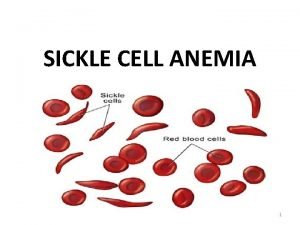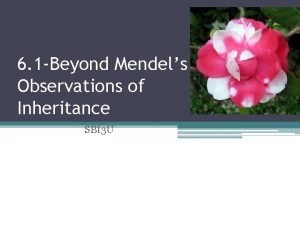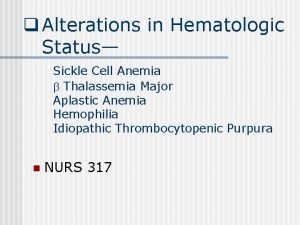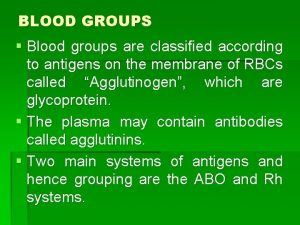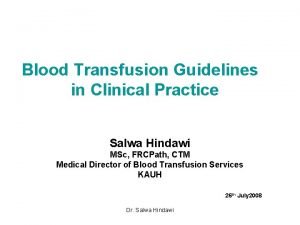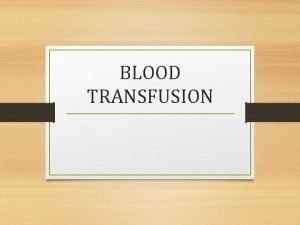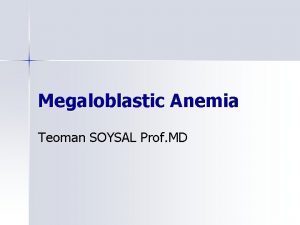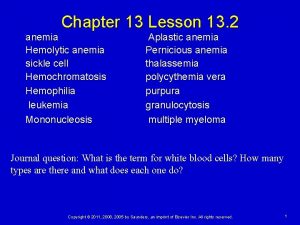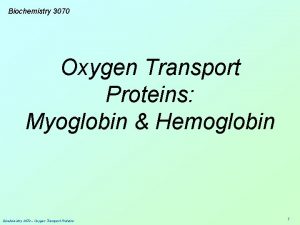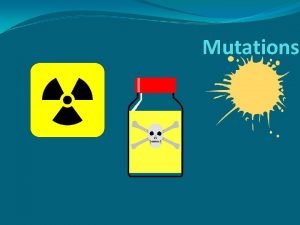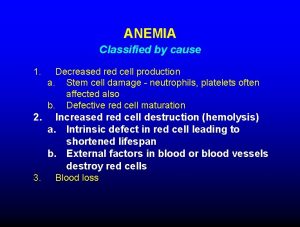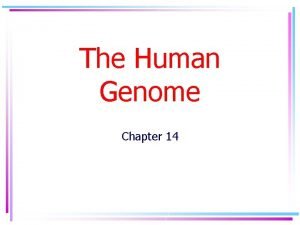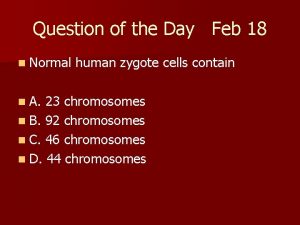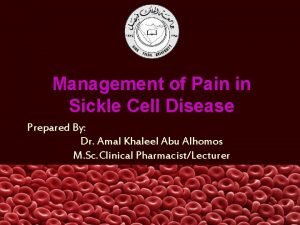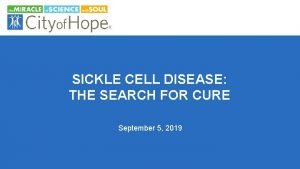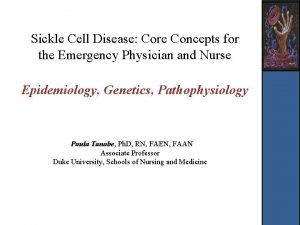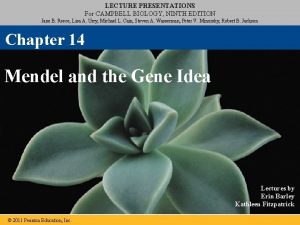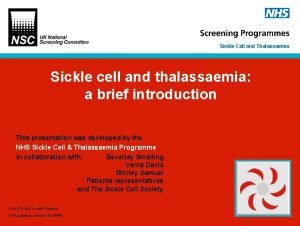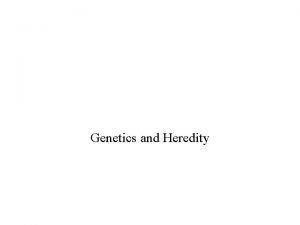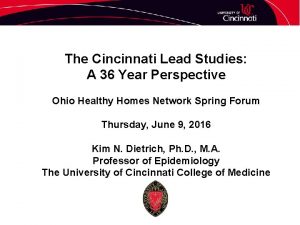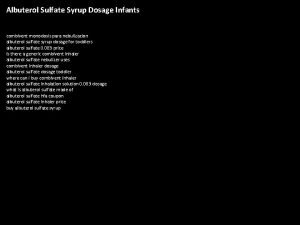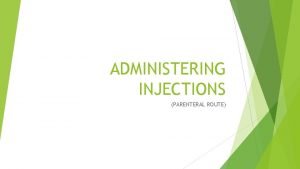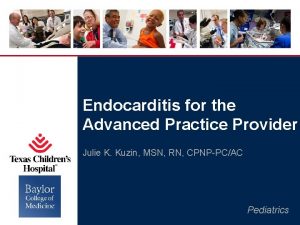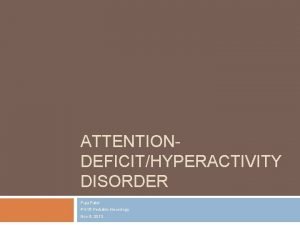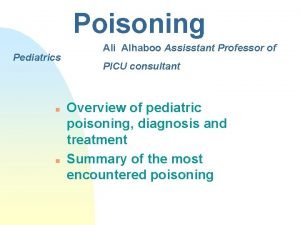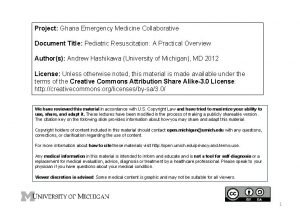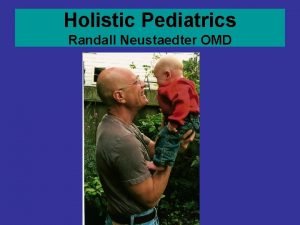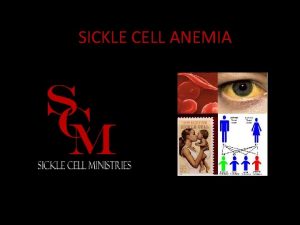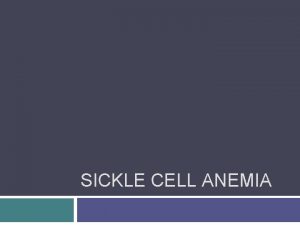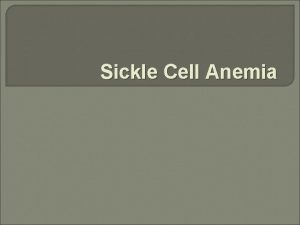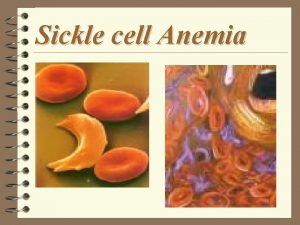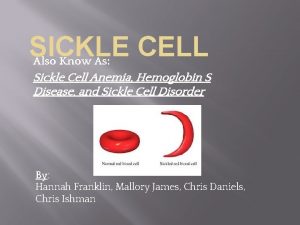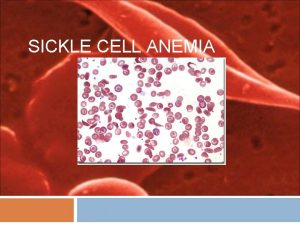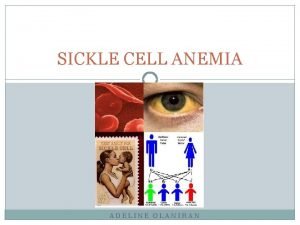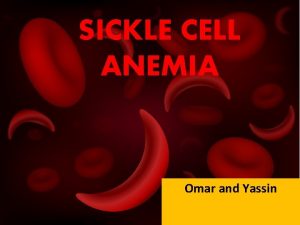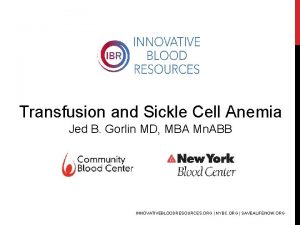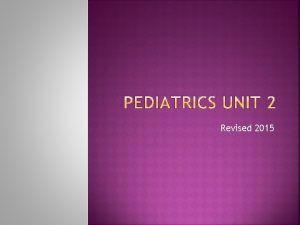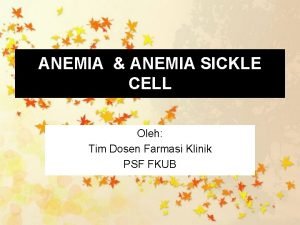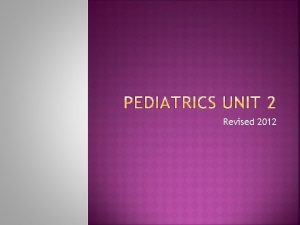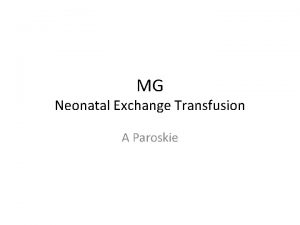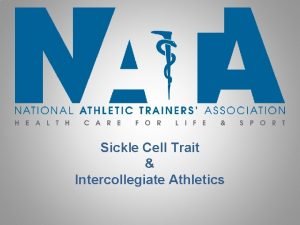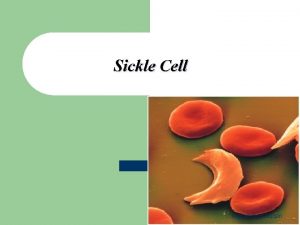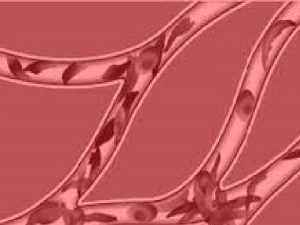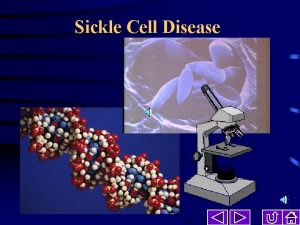Transfusion Sickle Cell Anemia in Pediatrics Allison Paroskie
























































- Slides: 56

Transfusion & Sickle Cell Anemia in Pediatrics Allison Paroskie

Outline • SCA: background • Transfusion therapy – Acute treatment • • Acute anemia Acute chest syndrome Stroke Preoperative transfusion – Chronic treatment • Stroke • Vaso-occlusive painful episodes • Acute chest syndrome • Complications of transfusion – Alloimmunization – Iron overload

Sickle Cell Anemia

Sickle Cell Anemia • Inherited blood disorder of red blood cells – 1 in 500 African Americans (1 in 12 AA are carriers) • Autosomal recessive genetic disorder – Defect in beta globin gene on chromosome 11 – Results in a substitution of valine for glutamic acid • Hemoglobin variants: SS, SC, S-β+thal, S-β 0 thal & rare variants – Clinically heterogeneous http: //sickle. bwh. harvard. edu/hbsynthesis. html

Pathogenesis • RBCs – Irreversible sickling – Increased blood viscosity • Hypercoagulability – Increased thrombin generation – Increased platelet activation – Endothelial dysfunction • Increased adhesion to vascular endothelium • Increased inflammation http: //imagebank. hematology. org/Asset. Detail. aspx? Asset. ID=3958&Asset. Type=Asset

Clinical Complications • Bacterial infection osteomyelitis – pneumonia – sepsis (encapsulated organisms) • • • Acute pain crisis Acute chest syndrome Acute splenic sequestration Aplastic crisis Stroke Priaprism Ulcers Avascular necrosis Pulmonary hypertension • Dactylitis (painful swelling of hands & feet) • Hepatic & biliary complications – Cholelithiasis & cholecystitis – Hepatopathy • Ocular complications – Retinopathy – Vitreous hemorrhages – Retinal detachment • Renal complications – Acute papillary necrosis – Chronic renal failure (hypertension, proteinuria) • Multi-organ failure

Transfusion Therapy

RBC Transfusions in SCA • Approximately 90% of patients with SCA will receive at least 1 RBC transfusion • Goals of RBC transfusion – Improving oxygen carrying capacity by increasing Hgb level – Decreasing blood viscosity and increasing oxygen saturation by decreasing Hgb S % – Suppressing endogenous production of sickle RBCs by increasing tissue oxygenation

RBC Transfusions in SCA Intermittent / Acute Prophylactic versus Simple versus Chronic Therapeutic Exchange

Clinical Indications Transfusion Medicine Reviews. 2007; 21: 118 -133.

Acute Transfusion

Acute Symptomatic Anemia When / Why to Transfuse • Symptomatic anemia – Blood loss – Increased RBC destruction – Suppression of erythropoiesis • Reticulocytopenia • Parvovirus B 19 – Sequestration How to Transfuse • Therapeutic intermittent simple RBC transfusion – Improve symptoms of cardiac and respiratory compromise – Slow and small volume +/diuretic therapy • Second-line therapy – Partial manual exchange transfusion (aplastic crisis) – Chronic simple transfusion (recurrent splenic sequestration)

Acute Stroke When / Why to Transfuse • Symptomatic stroke – – – Transfusion ASAP Restore cerebral blood flow Maximize tissue O 2 delivery Reverse neurological injury Prevent ↑ neurological injury How to Transfuse • Transfusion – Hgb S% < 30% – Hgb 9 – 10 g/d. L • Exchange versus simple – Optimal method for best neurologic outcomes is not clear – ASFA Category I – Recurrent stroke risk Journal of Clinical Apheresis. 2013; 28: 145 -284. The Journal of Pediatrics. 2006; 149: 710=712.

Acute Chest Syndrome When / Why to Transfuse • ACS: new pulmonary infiltrate + respiratory symptoms, chest pain or fever – Mild respiratory symptoms – Progressive decline in Pa. O 2 or O 2 saturation despite supplemental O 2 – Clinical deterioration How to Transfuse • Exchange versus simple – Mild symptoms: simple – Severe symptoms: exchange • Hgb S% < 30% • Hgb 9 – 11 g/d. L – ASFA Category II • Transfusion results in improved oxygenation Journal of Clinical Apheresis. 2013; 28: 145 -284 NEJM. 2000; 342: 1855 -1865.

Preoperative When / Why to Transfuse • Prophylactic preoperative – Mortality < 10% – Post-op complications < 5% • Hypoxia, hypoperfusion & acidosis promote sickling • Vaso-occlusion & organ dysfunction How to Transfuse • Exchange versus simple – Aggressive regimen – exchange • Hgb 9 – 11 g/d. L • Hgb S% < 30% – Conservative regimen – simple • Hgb 9 – 11 g/d. L • TAPS NEJM. 1995; 333: 206 -213. The Lancet. 2013; 381: 930 -938.

Priapism When / Why to Transfuse • Treatment goal: urgent relief of pain, prompt penile detumescence while preventing corporeal ischemia • Treatment – Conservative: aspiration, sympathomimetic drugs – Surgery: penile shunts or prosthesis How to Transfuse • Transfusion should occur in conjunction with primary priapism treatments – +/- efficacy of transfusion in achieving detumescence • Concern: ASPEN syndrome – Reported 9 times in the medical literature – Resolution > Severe neurologic deficits Nat Rev Urol. 2011; 8: 223 -230. British Journal of Haematology. 2013; 160: 754 -765. Can J Emerg Med. 2006; 8: 119 -122.

Chronic Transfusion

Goals • Dilution of Hgb S via addition of Hgb A • Suppression of erythropoietin release via rise in Hgb, thus reduced production of Hgb S • Decreased Hgb S due to longer lifespan of Hgb A containing RBCs

Stroke Prevention

Overview • Stroke occurs by age 20 in ~11% of patients with sickle cell anemia – Risk of recurrent stroke is estimated at 47 -93% • Increased risk of stroke in patients with abnormal TCD – Relative risk of 44 Blood. 1998; 91: 288 -295. Annals of Neurology. 1997; 42: 699 -704.

Chronic Transfusion s/p CNS Infarct • – 15 children: goal < 40% Hgb S pre-transfusion • > 9 months of transfusion therapy • 14 without new episodes of CNS infarction • – 12 children; goal < 20% Hgb S pre-transfusion • 7 of 10 children had recurrent stroke after CTX stopped • – 60 children; goal < 20% Hgb S pre-transfusion • 8 (13. 3%) children had recurrent strokes despite transfusion therapy Am J Hematol. 1976; 1: 265 -273. J Pediatr. 1980; 96: 205 -208. J Pediatr. 1995; 126: 896 -899.

• Purpose: to determine if chronic transfusion therapy can prevent stroke in patients with abnormal transcranial Doppler • Methods – Prospective randomized study – Patients: abnormal TCD x 2 • Baseline: 9. 7% with abnormal TCD – CTX: goal of pre-transfusion Hgb S < 30% and HCT 36%; Rh & Kell matched • 46 (78%) with at least one Hgb S % > 30% NEJM. 1998; 339: 5 -11.

• Stroke – 1/63 child CTX – 11/67 children SOC • CTX prevents stroke in children with abnormal TCD – Mechanism is unclear – Necessary duration is unclear NEJM. 1998; 339: 5 -11.

• Purpose: to determine if we could limit prophylaxis by monitoring patients with TCD and resuming transfusion if return to abnormal • Methods – Prospective randomized study – Patients: normalized TCD x 2 after 30+ months of CTX – CTX: goal of pre-transfusion Hgb S < 30% and HCT 36 g/d. L; Rh & Kell matched – Composite endpoint: abnl TCD or stroke NEJM. 2005; 353: 2769 -2778.

• Early closure by NHLBI – 14 abnormal TCD & 2 strokes in no transfusion group NEJM. 2005; 353: 2769 -2778.

NEJM. 2005; 353: 2769 -2778.

Higher Hemoglobin S % Goal • 13 patients free of recurrent stroke for > 4 yrs – Goal Hgb S % 60% – 10 pts > 1 year • No recurrent stroke • Decreased blood requirements by mean 43. 9% (simple) and mean 31. 4% (exchange) • 15 patients free of recurrent stroke for > 4 yrs – Goal Hgb S % 50% – 85 pt-years of follow-up • No recurrent stroke • Decreased blood requirements by mean 31% (simple) and mean 67% (exchange) J Pediatr. 1992; 120: 54 -57. Blood. 1992: 79: 1657 -1661.

Stroke Despite Hgb S % < 30% • Retrospective cohort study • 137 patients on CTX > 5 years – Goal Hgb S % 30% x 3 years – Goal Hgb S % at 3 years after stroke: 30 – 50% • Prospective cohort study • 40 patients on CTX therapy – Goal Hgb S % 30% • 31 (23%) had second stroke • Decreased risk of recurrent strokes if identified medical or concurrent event with initial event J Pediatr. 2002; 140: 348 -354. Blood. 2011; 117: 772 -779.

• Purpose: to determine the efficacy of hydroxyurea/phlebotomy compared with transfusions/chelation for children with SCA, stroke and iron overload • Methods – Prospective randomized noninferiority study – Patients: previous stroke and > 18 months transfusions and documented iron overload – CTX: goal of pre-transfusion Hgb S < 30% + chelation at MD discretion Blood. 2012; 119: 3925 -3932.

• Early closure by NHLBI * – Strokes • 7 / 67 (10%) in HU/phlebotomy • 0/66 (0%) in CTX/chelation – Iron overload • 15. 7 mg/g liver in HU/phlebotomy • 16. 6 mg/g liver in CTX/chelation * Full enrollment, 78% patient-years complete, 33% subjects with all exit data Blood. 2012; 119: 3925 -3932.

Summary of Stroke • Recurrence Rate – 67 % without treatment (Am J Med. 1978; 65(3): 461 -71) – 50% with cessation of transfusions (J Pediatr 1991; 118(3): 377 -82. ) – 22% (2. 2 per 100 pt yrs) with transfusion (J Pediatr. 2002; 140(3): 348 -54) • Risk higher in first 2 yrs after initial stroke • Initial treatment should include exchange transfusion (J Pediatr. 2006, 149(5): 710 -2) • Approximately 45% of the patients that are rigorously transfused will have progressive disease (overt or silent strokes) (Blood. 2011 Jan 20; 117(3): 772 -9. – Progressive CNS lesions based on progressive vascolopathy

Stroke Conclusions • Chronic transfusion therapy should maintain pretransfusion Hgb S % < 30% and HCT 30% – Post-transfusion goal: Hgb S% 15 to 20%, to keep maximum Hgb S% < 30% • Minimal data to support goal Hgb S % < 50% after 4 years of therapy • Transition to hydroxyurea is not supported • The major concerns for chronic transfusion therapy are iron overload and alloimmunization

VOC Pain and Acute Chest Syndrome

• Purpose: to determine whether prophylactic blood-transfusion therapy during pregnancy reduced maternal and fetal morbidity • Methods – Randomization < 28 weeks GA – Patients: 36 prophylactic tx, 36 no prophylactic tx • 28 additional patients studied without randomization – CTX: max Hgb S 35% and Hgb 10 – 11 g/d. L NEJM. 1988; 319: 1447 -1452.

NEJM. 1988; 319: 1447 -1452.

• Purpose: does long-term transfusion regimen decrease hospitalizations for SCA illnesses • Methods – Medical records review before, during and after long-term transfusion – Patients: 13 CVA, 4 intractable pain – CTX: monthly, goal of pre-transfusion Hgb S < 30% and Hgb 10 – 12 g/d. L J Pediatr. 1994; 125: 909 -911.

• All patients demonstrated iron overload, which was controlled with chelation J Pediatr. 1994; 125: 909 -911.

• Purpose: determine the impact of chronic transfusion on the incidence and frequency of pain and ACS • Methods – Sub-analysis of STOP trial data – Patients: 63 chronic transfusion, 67 observation – CTX: q 21 -days, goal of pre-transfusion Hgb S < 30% and HCT < 36% J Pediatr. 2001; 139: 785 -789.

• Events – All: prior Hgb S <30% – All – 1: tx within 30 d • Ferritin increase: 164 μg/L 1804 μg/L • Alloimmunization: 29% versus 21% J Pediatr. 2001; 139: 785 -789.

• Purpose: evaluation of clinical approach to manage patients with recurrent or severe ACS with chronic transfusion • Methods – Retrospective review – Patients: 7 single severe ACS episode, 20 recurrent ACS; CTX > 4 months – CTX: q 4 -weeks, goal of pre-transfusion Hgb S % < 50%; C, E and Kell matched J Pediatr Hematol Oncol. 2005; 27: 158. 161.

• Pre-tx Hgb S % – 30 -50% in 74% – < 30% in 26% • ACS – Pre: 1. 3 episodes/pt-yr – Post: 0. 1 episodes/pt-yr • Ferritin – Pre: 593 ng/m. L – Post: 1908 ng/m. L • Alloimmunization – 4 patients (15%) J Pediatr Hematol Oncol. 2005; 27: 158. 161.

• Purpose: determine whethere were differences in non-neurologic events comparing chronic transfusion & hydroxyurea • Methods – Sub-analysis of SWi. TCH trial data – Patients: 67 chronic transfusion, 67 HU – CTX: q 4 -weeks +/- 1 week, goal of pre-transfusion Hgb S < 30% Am J Hematol. 2013; 88: 932 -938.

Am J Hematol. 2013; 88: 932 -938.

Pain & ACS Conclusions • Chronic transfusion therapy may decrease incidence of VOC painful episodes and ACS however data is equivocal – Pre-transfusion values • Hgb S % < 30 – 50% • Hgb < 10 -12 g/d. L • Larger randomized trial to demonstrate true effect of chronic transfusion for VOC & ACS

Complications of Transfusion

Alloimmunization • Development of antibodies due to antigenic differences between donor and recipient RBCs • Multi-factorial pathophysiology – Increased number of transfusions – Differences between immunogenic RBC antigens • Phenotypic matching C, E and K 3% to 0. 5% per unit – Rare antigenic variants – Individual-specific susceptibility • HLA genotype: HLA-DRB 1*1503 ( risk) HLA-DRB 1*0901 ( risk) • Reduced Treg suppressive function ( risk) – SCD-specific susceptibility • Chronic inflammation Transfusion. 2001; 41: 1086 -1092. Am J Hematol. 2009; 84: 462 -464. Am J Hematol. 2011. 86: 1001 -1006.

Alloimmunization Risk with Transfusions • Retrospective analysis of chronic transfusion program – (- ab) C, E and K matched – (+ ab) Fya&b, Jka&b, S, s, M, N • 45 patients on CTX – 22 ECP: 7447 units – 23 simple: 3502 units Transfusion. 2012; 52: 2671 -276.

Blood Transfusion & Iron Overload • Iron accumulation is related to duration of chronic RBC transfusion / total volume of RBCs transfused – +/- Chelation therapy with deferoxamine Blood. 2000; 96: 76 -79. J Pedi Hematol / Oncol. 2002. 24: 284 -290.

Blood Transfusion & Iron Overload • Iron accumulation is related to duration of chronic RBC transfusion • Improved chelation (deferasirox) and transfusion type (simple versus exchange) may influence affect Am J Hematol. 2012: 87: 221 -223.

Blood Transfusion & Iron Overload • Iron accumulation results in cardiac disease – Circles: < 33% ferritin > 2500 ng/m. L – Squares: 33 -67% ferritin > 2500 ng/m. L – Triangles: > 67% ferritin > 2500 ng/m. L Vox Sang. 2009; 97: 185 -197.

Effects of Erythrocytapheresis Transfus Med Hemother. 2008; 35: 24 -30.

Effects of Erythrocytapheresis J Pediatr Hematol / Oncol. 1996; 18: 46 -50.

Effects of Erythrocytapheresis Blood. 1994; 83: 1136 -1142. Hematology. 2013: 447 -456.

Summary

Acute Transfusion Disease Complication Transfusion Type Goals Acute Anemia Simple Improvement of symptomatic anemia Acute Stroke Exchange Minimize progressive neurovascular sickling • Hgb S% < 30% • Hgb 9 – 10 g/d. L Acute Chest Syndrome Simple or exchange Improved oxygenation • Hgb 9 – 10 g/d. L • +/- Hgb S% < 30% Pre-operative Simple Minimization of postoperative complications • Hgb 9 – 11 g/d. L Priapism N/A Transfusion only if clinically indicated beyond priapism symptoms

Chronic Transfusion Disease Complication Transfusion Type Goals Stroke – primary and secondary prevention Chronic Pre-transfusion • Hgb S% < 30% • < 50 % after 4 years * • Hgb S% 15 -20% (post) • Hgb 10 -12 g/d. L Recurrent VOC Pain Chronic ** Pre-transfusion • Hgb S% < 30 -50% • Hgb 10 -12 g/d. L Recurrent ACS Chronic ** Pre-transfusion • Hgb S% < 30 -50% • Hgb 10 -12 g/d. L * Based on two small studies; no randomized prospective trials ** Observational and secondary analysis data • Phenotypic matching (Rh & Kell) is of critical importance in minimization of alloimmunization – Effect (if any) of ECP on rate of alloimmunization is currently unknown • Iron overload is a significant complication of chronic transfusion – Chelation and/or exchange transfusion can minimize risk of iron overload
 Causes of sickle cell anemia
Causes of sickle cell anemia Is sickle cell anemia codominant
Is sickle cell anemia codominant Sickle cell anemia dna sequence
Sickle cell anemia dna sequence Sickle cell anemia
Sickle cell anemia 4 steps of protein synthesis
4 steps of protein synthesis Sickle cell anemia mutation
Sickle cell anemia mutation Sickle cell anemia
Sickle cell anemia Persilangan thalasemia
Persilangan thalasemia Sickle cell anemia
Sickle cell anemia Sickle cell pedigree
Sickle cell pedigree Inheritance pattern of sickle cell anemia
Inheritance pattern of sickle cell anemia Sickle cell anemia due to
Sickle cell anemia due to Sickle cell anaemia
Sickle cell anaemia Genotypic ratio of monohybrid cross
Genotypic ratio of monohybrid cross Sickle cell anemia symptoms
Sickle cell anemia symptoms Types of sickle cell disease
Types of sickle cell disease Sickle cells
Sickle cells Sickle cell anaemia
Sickle cell anaemia Sickle cell anemia lab values
Sickle cell anemia lab values Blood transfusion indications
Blood transfusion indications Indications for blood transfusion in anemia
Indications for blood transfusion in anemia Indications for blood transfusion in anemia
Indications for blood transfusion in anemia Megaloblastic anemia
Megaloblastic anemia Megaloblastic anemia vs pernicious anemia
Megaloblastic anemia vs pernicious anemia Polycythemia differential diagnosis
Polycythemia differential diagnosis Sickle cell osteomyelitis
Sickle cell osteomyelitis Sickle cell pain
Sickle cell pain Sickle cell hemoglobin structure
Sickle cell hemoglobin structure What type of mutation is cri du chat syndrome
What type of mutation is cri du chat syndrome Film
Film Chapter 14 the human genome making karyotypes answer key
Chapter 14 the human genome making karyotypes answer key Types of sickle cell disease
Types of sickle cell disease Sickle cell punnett square
Sickle cell punnett square Pethidine in sickle cell
Pethidine in sickle cell Sickle blood cell
Sickle blood cell Life expectancy of sickle cell patients
Life expectancy of sickle cell patients Pbs sickle cell
Pbs sickle cell Gene therapy for sickle cell disease
Gene therapy for sickle cell disease Nata sickle cell
Nata sickle cell Difference between sickle cell anaemia and thalassemia
Difference between sickle cell anaemia and thalassemia Hemophilia karyotype picture
Hemophilia karyotype picture Pediatric book rimple sharma pdf download
Pediatric book rimple sharma pdf download Normal range for vital signs
Normal range for vital signs Tlc pediatrics flint
Tlc pediatrics flint Combivent monodosis
Combivent monodosis Practical approach pediatrics
Practical approach pediatrics Im injection sites and volumes pediatrics
Im injection sites and volumes pediatrics Npass pain scale
Npass pain scale Disease xxx
Disease xxx Lsu pediatric residency
Lsu pediatric residency 11yo
11yo Psychiatry shelf percentiles
Psychiatry shelf percentiles Normal vital signs of newborn
Normal vital signs of newborn When administering ear drops to adults the pinna is pulled
When administering ear drops to adults the pinna is pulled Nn pediatrics
Nn pediatrics What are normal vital signs
What are normal vital signs Randall neustaedter
Randall neustaedter
